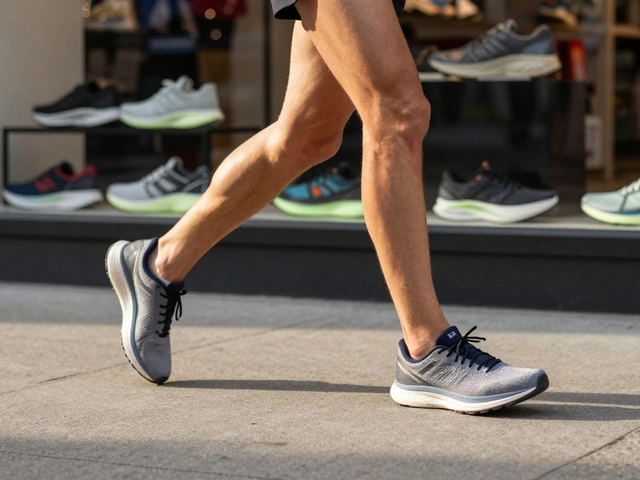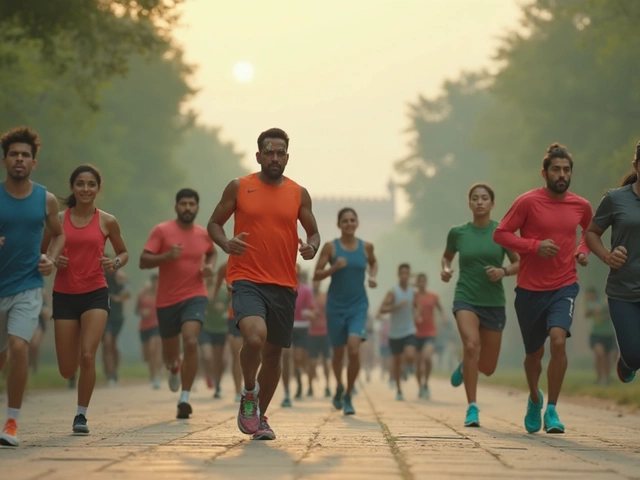If you check out most parks or city sidewalks, you'll spot tons of people wearing running shoes even when they're just out for a stroll. Doesn't matter whether they're speed-walking their way to work or heading for coffee, running shoes have pretty much taken over the sidewalks. Ever wondered if that's actually okay or if you should really be looking for a pair made just for walking?
What Makes Running Shoes Different from Walking Shoes?
Let’s get into what truly sets running shoes apart from walking shoes, because spoiler alert—they aren't just marketing gimmicks. The real difference is in the tech that goes into the soles and how the whole shoe handles your foot movement.
First off, running shoes are designed for high-impact activity. When you run, every step pounds the ground at about three times your body weight. That’s why running shoes are loaded with more cushioning, especially at the heel, and are lighter to encourage fast foot motion. The heel-to-toe drop—the difference in height between the heel and the forefoot—is usually higher, which helps absorb the shock of heel-first landings.
Walking, on the other hand, is a low-impact activity. Walking shoes have a lower heel-to-toe drop and often focus on providing consistent support all along your foot through a firmer, flatter sole. This supports a rolling motion from heel to toe, which is how our feet naturally move while walking. The shoes are also a bit stiffer in the midsole to reduce stress on the arch and joints during repeats of this gentler gait cycle.
The American Orthopaedic Foot & Ankle Society actually recommends picking shoes based on what you’ll do most—run or walk—because the mechanics are just so different. Take a look at the stats from a 2023 Running Industry report below, which outlines what people use their athletic shoes for most often:
| Activity | Primary Shoe Used | Reported Comfort (%) |
|---|---|---|
| Running | Running Shoes | 89% |
| Walking | Running Shoes | 68% |
| Walking | Walking Shoes | 94% |
No surprise—comfort scores go up when people match their shoes to their activity. And yet, nearly three out of four people wear running shoes even for their regular walks. So should you?

The Real-World Pros & Cons of Walking in Running Shoes
Before you start purging your shoe rack, let’s talk about what happens when you actually use running shoes for walking. You’re not breaking any rules, but there are some things worth knowing if you want happy feet.
The best thing about running shoes for walking is the cushion. Walking can be hard on joints if you have knee or hip trouble, and that extra padding can make each step feel lighter. If your walks include hills or you switch between walking, jogging, and random sprints (thanks to that dog that just bolted), running shoes will adapt to the intensity. This is probably why walking in running shoes feels totally fine for most people, especially if you’re just out for a casual stroll.
But running shoes aren’t a perfect match for every walker. If you clock in long miles every day—think fitness walkers, mail carriers, or folks who trek for 10,000+ steps a day—all that cushioning may feel too squishy. Your feet might sink, causing extra motion in unexpected directions, which can make your ankles work harder. That’s when you might start feeling aches or hot spots, particularly in the arches or the balls of your feet. It’s surprisingly common for walkers to develop blisters in running shoes because many models use mesh uppers to keep them light, but that same feature can bring rubbing or sliding if the fit isn’t spot on.
Another thing: when walking fast or for hours, stability matters. The built-in arch and heel construction of walking shoes helps keep your foot aligned. With running shoes, some models (especially the really spongy ones or those designed for racing) can let your foot tilt in or roll out, especially if your gait is a bit wonky. That’s not an issue if you’re wearing them for errands, but it can sneak up on you after weeks of daily use.
There’s also the money factor. Top-notch running shoes can run you Rs 7,000 to more than Rs 15,000 at Indian retail. Using them only for walking means you could wear down the outsoles and cushioning faster than if you saved them for runs, especially since the motion of walking puts pressure on different parts of the sole.
Personal tip: If you have past injuries, shin splints, plantar fasciitis, or bunions, you might want a shoe designed specifically for walking. Many walking-specific shoes are built extra-wide in the toe box and have additional stability to correct foot roll, which is usually unnecessary for runners but a lifesaver for walkers. Consider visiting a real specialty store at least once and getting your gait analyzed. The advice makes a difference, even if you end up buying from Amazon later!

How to Choose the Best Shoes for Your Daily Walks
Now, here’s where it gets practical. If your walks are 20–40 minutes a few times weekly and you already own running shoes that feel good, you’re totally fine. But if you’re starting to take walking more seriously—say, tackling a 5K or aiming for 50,000 steps a week—consider what matters most for foot health and comfort.
- Fit above all: The running shoes or walking shoes need to fit snug but not tight, with a thumb’s width of space at the toe. Feet swell during activity, so always try on shoes later in the day with the socks you’ll actually wear out walking.
- Test for flex: Bend the shoe in your hands. It should flex at the ball of your foot, just where you push off while walking. Super stiff soles (often in cheap running shoes) will cause aches.
- Heel drop: For mainly walking, look for a heel drop (difference in sole thickness between heel and toe) of 8mm or less. High heel drops (10mm or more) are often found in running shoes but can cause your heel to slap the ground while walking.
- Arch support: Everybody’s feet are different. If you have flat feet or high arches, check for shoes with built-in arch support or add an orthotic insole. Cheap foam insoles can make a big difference for tired feet on long walks.
- Outsole grip: If you’re walking outdoors, especially on wet roads or trails, pay attention to the outsole. Some running shoes are made for dry pavement only and get slippery in rain.
- Cushion level: Plush cushioning can feel nice, but if you go too soft on daily walks, you might lose stability. Many experienced walkers prefer a firmer midsole than what you’d use for running marathons.
Another thing to check is shoe weight. Heavy shoes can drag you down on long walks, but too lightweight might mean less durability and support. A good pair of walking shoes weighs about 250–350 grams (for women’s size 7-8). Most regular running shoes fall in a similar range, so if you find a pair you love, that’s one less thing to worry about.
Let’s not forget about style—walking shoes sometimes have a reputation for looking old-school, but brands are finally catching up. These days, New Balance, Skechers, and even ASICs have everyday walking shoes that could pass off as streetwear.
The bottom line? If you’re happy using your running shoes for walking, and you feel comfortable and pain-free after walks, there’s no urgent reason to change. Just keep in mind that over time, running shoes will lose their bounce and may not protect you as well against hard surfaces. Make a habit of checking your shoes every 300–500 kilometers (that’s every six months for most casual walkers), and swap them out if you see worn treads or flattened cushioning.
Your feet do a lot of heavy lifting—so reward them with the best fit you can afford and enjoy every step, whether you’re walking, jogging, or just chasing down that last metro train.





